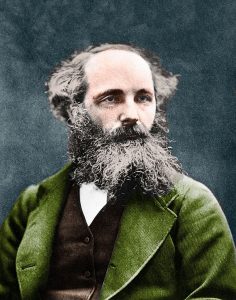
By 1861, the Scottish scientist James Clerk Maxwell (1831-1879) had found the famous equations for electromagnetism that today bear his name.
They are a system of partial derivative equations that describe the electric and magnetic fields. Each of these two force fields links a three-dimensional vector to each point in space, and varies with time. Maxwell’s equations establish how the coordinates of the vectors defining the fields vary as we move through space, and how they vary as time varies. Furthermore, the equations link both fields, so that the existence and values of one completely determine the existence and values of the other.
Maxwell thought his equations were a faithful mathematical model for electromagnetism; he was right, and his equations are now considered the cornerstone of classical electromagnetism, although they have had to be modified to accommodate the quantum effects of the atomic world.
Maxwell therefore believed that electromagnetic phenomena could be explained either by one of his equations or by some other equations that could be obtained by manipulating them. Now, if the mathematical model is correct, its study generally leads to the discovery of new aspects of the natural phenomena it represents. In other words, research on the mathematical model allows us to predict certain features and behaviours of the reality it is used to model. This is also the way to check how reliable the model is at representing reality: with each prediction that is subsequently observed in reality, confidence in the model increases, while if its predictions are not observed, or if something contrary to what was predicted is observed, the model is rejected.
When Maxwell came up with his equations, he drew from them a spectacular prediction. By properly manipulating the equations, he deduced that the magnetic field and the electric field were perpendicular and that both verified what is known as the wave equation. In other words, at any instant the vectors corresponding to the fields at a point are perpendicular, and each vector fluctuates as time varies as if it were the amplitude of a wave propagating with finite speed in a direction perpendicular to that of both fields. This interpretation allowed the electric and magnetic fields to be considered as if they were waves, which were obviously christened electromagnetic waves.

This groundbreaking discovery – the wave nature of electromagnetic fields – was made by Maxwell in the summer of 1861 on his Scottish estate at Glenair. But that was not all he discovered. One of the elements that appears explicitly in the wave equation is the speed at which the wave travels. In the case of electromagnetic waves, Maxwell managed, after considerable effort and finesse of thought, to put this speed in terms of known constants of electromagnetism: for an electromagnetic field, the speed of wave travel is equal to the quotient of the electrostatic and electromagnetic units. But it turned out that Maxwell had no books at Glenair to consult for the value of these units, and the calculation of the velocity of propagation of electromagnetic waves had to wait until October when he returned to London, where he held a professorship at King’s College. There, a huge surprise awaited him.
The data he needed for his calculation had been determined years earlier by Wilhelm Weber and his colleague Rudolf Kohlrausch. Applied to Maxwell’s calculations, what they said was that electromagnetic waves always travel at a speed suspiciously close to that of light. It was an astonishing discovery indeed, and it made Maxwell the happiest of humans; in Einstein’s words – written on the occasion of the centenary of his birth: “The feelings he must have felt when he realised that the equations he had formulated indicated that electromagnetic fields expand as polarised waves and at the speed of light! Very few men in the world have been granted such an experience”. Maxwell immediately shared this experience with his friend and colleague William Thomson – later Lord Kelvin – to whom he wrote in December 1861: “The speed of transverse undulations of an electromagnetic field is equal to 310,737 kilometres per second, very close to the speed of light. I developed the equations in the field, before I had any suspicion of the proximity between the two values of the velocity of propagation of magnetic effects and that of light, so that I think I have reason to believe that the magnetic and luminiferous media are identical”. But there was something else. This speed with which electromagnetic waves move is relative to what? As Maxwell had deduced it, this speed did not seem to be affected by the state of motion of the source, as if it were a constant associated with Maxwell’s equations. Almost half a century later, this would eventually catch the young Einstein’s attention, and suggest to him an idea that would give rise to his theory of special relativity.
These were the far-reaching conclusions that mathematics allowed Maxwell to make after finding the equations for electricity and magnetism: the fields are waves and appear to be of the same nature as those of light. Everything seemed to point to the fact that not only electricity and magnetism were twin phenomena, but that light – optics – was joining the family.
The problem is that, until then, no one had ever observed waves related to electricity and magnetism. Was this not one of the typical confusions that some experimental physicists blamed on the blind use of mathematics in science? The answer is no, but I will tell you about it in the next article.
Bibliography
Antonio J. Durán, El universo sobre nosotros, Crítica, 2015.

Leave a Reply